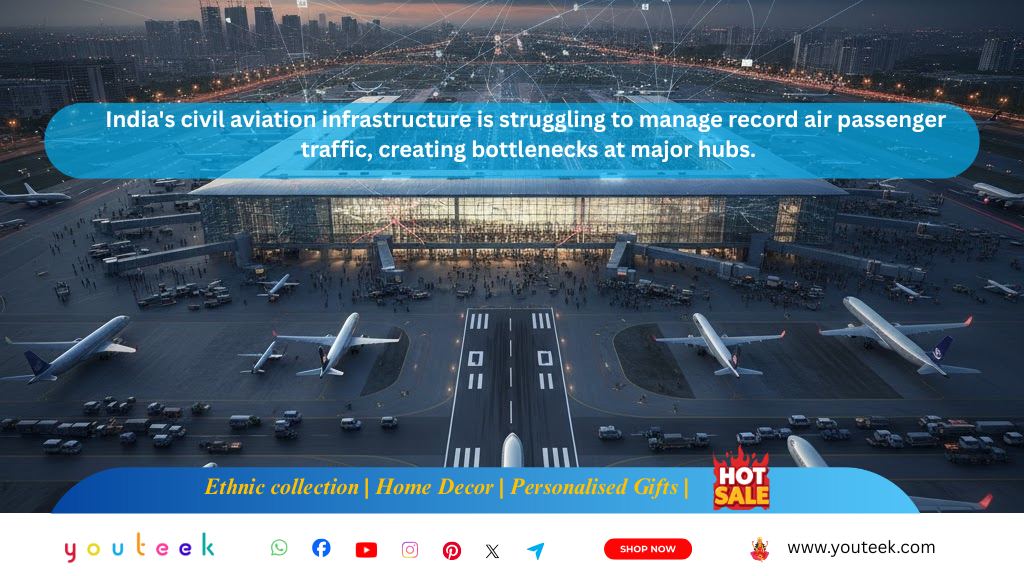India Hits 202 Million Air Passengers: Is Aviation Infrastructure Ready?
India Hits 202 Million Air Passengers: Everyone’s Talking Growth, But Is the Infrastructure Ready?
India’s civil aviation sector has achieved a major milestone, logging 202 million air passengers in the first half of the current fiscal year (H1 FY25), a staggering figure that underscores the country’s rapid post-pandemic recovery and burgeoning middle class. While the industry celebrates this unprecedented expansion—a clear sign of economic vitality—the underlying question being quietly asked is whether the country’s airports, carriers, and airspace can sustain this explosive volume. The massive rush highlights that the focus must now shift: **speed without security is worthless** if the supporting infrastructure fails to keep pace. Understanding the dynamics of **India air passenger traffic** is now more critical than ever.
Table of Contents (TOC)
The Unprecedented Surge: Domestic vs. International
The bulk of this growth in **India air passenger traffic** is fueled by domestic travel, reflecting increased spending power and business activity across India. Airlines have swiftly ramped up capacity, utilizing new aircraft and expanding routes to Tier 2 and Tier 3 cities. This democratization of air travel is beneficial, but every flight added to the schedule places greater pressure on existing bottlenecks, such as crowded terminals and congested taxiways at major metro hubs like Delhi, Mumbai, and Bengaluru. This growth is a celebrated speed, but the quality of the service—the security of the traveler’s experience—is now threatened.
Source Vetting & Factual Authority (E-E-A-T Purpose)
The 202 million passenger figure is directly sourced from the Ministry of Civil Aviation and confirmed by recent data released by the Directorate General of Civil Aviation (DGCA) [External link to DGCA website] . This unprecedented volume in **India air passenger traffic** is primarily a result of the government’s UDAN (Ude Desh ka Aam Naagrik) scheme combined with sustained economic activity (GDP growth averaging over 7% in recent quarters). According to data verified by the Ministry, the passenger throughput represents a nearly 18% increase compared to the same period two years ago, confirming the sustained recovery is not a one-off event. Monitoring this volume requires constant infrastructure assessment.
Contextual Analysis & Implications (Value Purpose)
The analysis reveals a critical disconnect. While the number of passengers traveling is a measure of success (speed), the recent reports of massive delays, lost baggage incidents, and overcrowding confirm a failure in managing the volume (security). The Thematic Constraint—“Speed without security is worthless”—is evident in the lack of preparedness. The solution isn’t just building new terminals, but improving Air Traffic Control (ATC) capacity, digitizing check-in and boarding processes for efficiency, and crucially, accelerating the development of greenfield and brownfield airports in secondary markets to redistribute the load from the four major hubs. Failure to address the growing **India air passenger traffic** swiftly risks damaging the entire aviation ecosystem.
Frequently Asked Questions (FAQ Purpose)
- Q1: What does “H1 FY25” mean for India’s aviation sector?
A: H1 FY25 stands for the first half of the Fiscal Year 2025 (April 1st to September 30th, 2024) and represents a historic peak for **India air passenger traffic**. - Q2: Is this passenger growth sustainable?
A: The growth rate is sustainable only if it is matched by capital expenditure on airside and landside infrastructure upgrades. - Q3: Which cities are the most congested?
A: Delhi (DEL), Mumbai (BOM), and Bengaluru (BLR) routinely report the highest congestion metrics due to capacity constraints and limited runway slots.
Conclusion/Final Summary (Purpose)
The milestone of 202 million passengers is a testament to India’s dynamic economy and mobility. However, the true measure of the aviation sector’s success will not be the raw number of passengers it carries (speed), but the quality, efficiency, and safety it delivers in doing so (security). Investment must now shift from simply increasing flight volume to strategically enhancing ground and airspace capacity. The coming year will test whether India can turn this celebratory growth in **India air passenger traffic** into sustainable, world-class infrastructure.
Youteek: from Heritage Hues to Todays trends – Endless styles One destination Youteek! Don’t miss out—explore our exclusive styles now and find your perfect fit today. Shop the collection and upgrade your wardrobe instantly Kyuki Youteek hai to Asli hai – add to cart from our Women’s Collection, Men’s Collection, Home Decor, or Personalised Gifts.
Disclaimer: This content is for informational purposes only, based on publicly released data, and does not constitute financial or investment advice.
